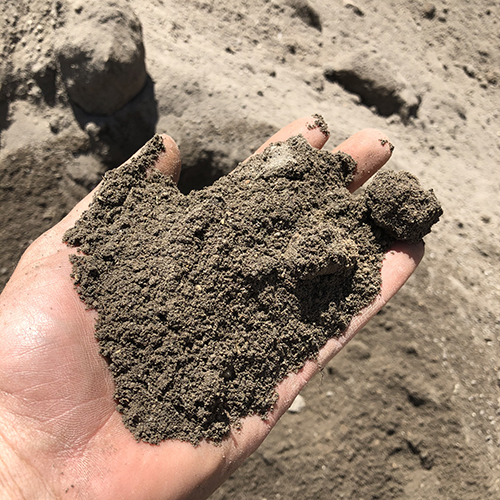What Exactly Is Topsoil?
According to the Merriam-Webster dictionary, topsoil is: “surface soil usually including the organic layer in which plants have most of their roots and which the farmer turns over in plowing.” Topsoil is the top 2-10 inches of material that contains most of the natural nutrients in the ground. The airspace within the soil is an essential aspect that will help you tremendously in the yard. Alison Pearce Stevens with Science News Explores says: “Most of what we see are mineral particles that we recognize as sand, silt, or clay. There is also plenty of water and air. But soil also is alive. Containing countless fungi and microbes, they help recycle the dead by breaking down the remains of plants, animals, and other organisms.”
Topsoil is full of life! “If you were to divide a healthy soil sample into 20 parts, 9 of those parts would comprise the stuff we think of as dirt: clay, silt, and sand. These are inorganic particles, which means they come from non-living sources. A full half, or ten parts, would be equally divided between air and water. The last part would be organic, made from dead and decaying organisms. The soil contains countless minuscule microbes, like fungi and bacteria.”

Why Is Topsoil Helpful?
Topsoil is helpful for a variety of reasons. It can be fruitful for plants and other life, like animals and fungi. Aside from being much of what we walk on; and where we build things, topsoil has many uses for humans. You can use topsoil for lawn care, garden maintenance, and even to help control drainage.
The soil microbes that help break down the dead material work to support the life of plants and fungi in a mutual exchange of resources. This relationship is called symbiosis. Symbiotic relationships are a symbolic element of topsoil. The dead nutrients broken down by the microbes are recycled back into the soil to provide fertility that helps sustain the plants and other life that rely on the land. Those organisms, like bugs and plants, end up feeding other plants, bugs, fungi, and animals in the circle of life.
Top 3 Uses for Topsoil
1. Lawn Care
Topsoil can be handy in a few ways when caring for your lawn. It is ideal when repairing any lawn damage. You can use topsoil to fill any low spots on your grass. To do that, add two-inch layers of topsoil onto the depressed places and level it out with a rake. The grass below will grow through that fresh layer of topsoil. If the low area is over two inches deep, repeat the process with only two inches of soil each time until the ground is level. More than two inches of topsoil could make it difficult for the existing grass below to grow through and survive.
Using topsoil to repair dead or damaged spots in your grass is another way that topsoil is valuable when caring for your lawn. Just spread a one-inch layer of topsoil mixed with grass seed onto the bare spots, level out, and water daily. Within a couple of weeks, lush grass will take over.
2. Garden Maintenance
Topsoil is beneficial in the garden to add material where you are lacking some. Adding nutrients like manure or compost is crucial to help the plants flourish. You can use topsoil to create a plant bed or add soil to an existing garden. To make a garden with topsoil, spread a two-inch thick layer down and then mix it with the existing soil to about six inches deep. That creates a transition layer for the new plants to adapt to the differences in the dirt. Finally, add topsoil to the top of the mixed layer until your garden is at your preferred depth. Adding fertilizer or other organic matter will result in the best plants.
You can also use topsoil as a foundation layer for a new garden.
3. Drainage/Erosion Control
Because topsoil has so many air pockets, it is excellent to help improve soil drainage. You can add topsoil to any area of the yard that holds water. Doing this will result in a dryer area. To create the best drainage, combine topsoil with some sand and organic material, then till it into the native soil roughly twelve inches deep.
Topsoil is one of the greatest assets to help control water erosion. Topsoil helps to prevent runoff and erosion by absorbing the water before it can cause damage. Water might collect and flow off surfaces like concrete or roads, causing unnecessary erosion. Topsoil is perfect for repairing any damage that has already been done and can even help prevent future damage. Whether you use it in your yard to assist with landscaping or it is what supports the community infrastructure, topsoil is a familiar friend.

